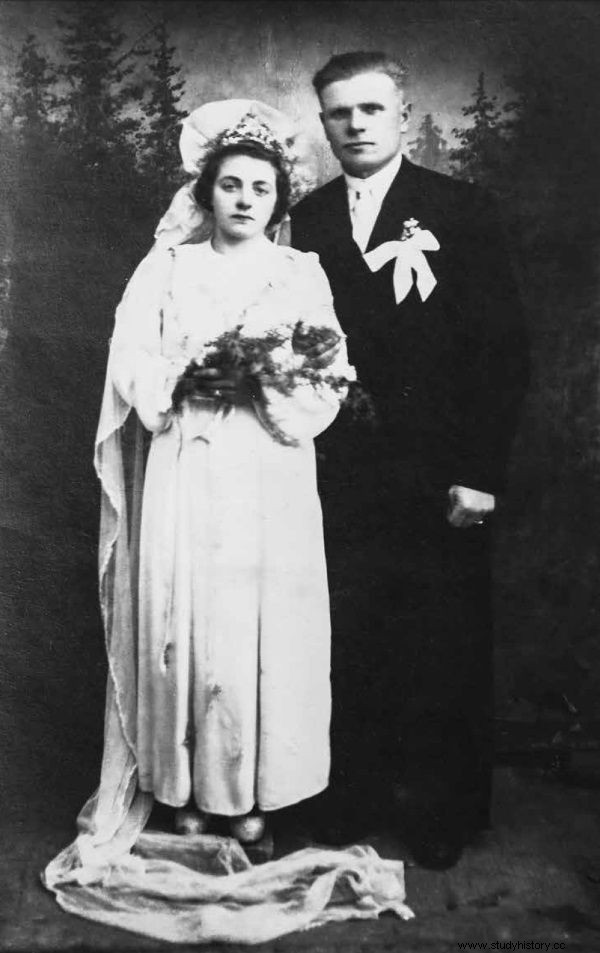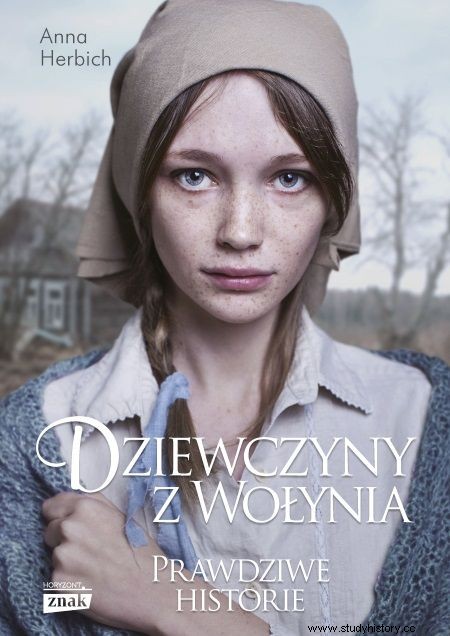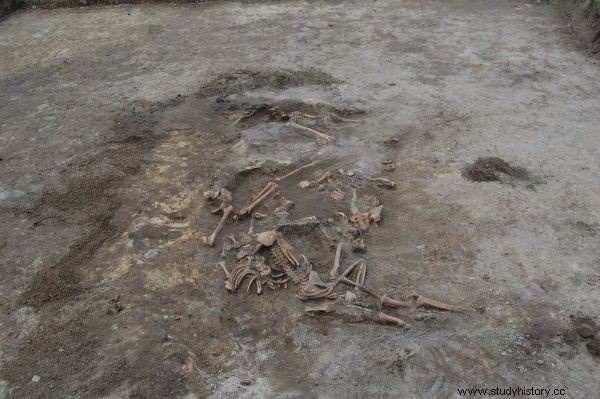The stories of people who managed to survive the Volhynian slaughter are full of dead bodies and unimaginable human tragedy. When the survivors fled, they had to leave the bodies of their loved ones behind. What happened to the corpses of the people who died at the hands of Ukrainian nationalists?
For many years, the crimes of Ukrainian nationalists against Poles did not exist in the collective memory of Ukraine. Members of the UPA units tried to exonerate them by throwing it on the OUN Bezpeky Service, considering the purges as "a spontaneous action by the Ukrainian population," which, in their opinion, sounded credible, because the murders were carried out using farm tools, e.g. forks, sickles or axes), or by claiming the Soviet guerrillas are to blame.
However, it is impossible to erase the fact that in 1943 people who are now considered Ukraine's heroes murdered in cold blood and on a mass scale. Many witnesses who managed to survive the massacres of their native villages were traumatized. Saving their lives, they ran away blindly, never looking back and never returning to their homes again. Meanwhile, in Polish villages, among the plundered and burnt buildings, the bodies of those who had not managed to escape the pogrom, their relatives, neighbors and friends remained. What happened to them when the murderers left?
Buried by murderers
Alfreda Magdziak, the heroine of the book "Girls from Volhynia" by Anna Herbich , was only seventeen when the Ukrainians attacked her native village. When the bandits showed up, she managed to hide in the fresh stubble and watched from a distance as her father and two sisters stood in the backyard of the house, surrounded by armed attackers. Before her eyes, her relatives were tortured. The bandits started with the kids, forcing their father to watch it. The torturers did not notice Alfreda. Meanwhile, she became aghast with horror as she watched the further course of events. As we can read in Herbich's book :
The UPA was looking for a place to bury the victims. They started digging. They carried the bodies on a ladder from our barn and threw them one by one into the common grave. Then they covered the pit, tamped the ground with shovels. And they left.

In 1946, the survivor of the Alfred massacre got married. (photo:press materials of the Znak Horyzont publishing house)
For a long time the girl lay motionless in her hiding place in the stubble. Only when dusk came and the nationalists were long gone did she dare to get up. She set off quietly, only to reach my aunt's house after three days of hiking.
In another town, Orzeszyn, the torturers decided to spare themselves the work. Instead of digging graves, they used former Soviet trenches. First, they gathered all the men. They ordered them to get on the carts and drive to the forest. They then lined them up in a row over the trenches and slashed them all down with a machine gun burst. Later they killed women, children and old people in the same way. In the end, it was enough to cover the death pits.
Found and buried by surviving relatives
Helena Zacharczuk should not have survived. When they escaped with their mother, brother and sister through deep snow, the Ukrainians chased them on horseback. Finally they caught up with them and started shooting. Helena also got two bullets and fell unconscious into the snow, and at that time their home village of Stefanówka was on fire. After the attackers left, the inhabitants who had survived returned for the wounded under cover of night. They also saved Helena at that time. As reported by the woman on the cards.
On Tuesday, two days after the massacre, my father, together with other inhabitants of Stefanówka, went to the place of execution to bury the murdered. The protection was provided by members of Polish self-defense armed with rifles from neighboring towns. Dad found the bodies of my mother and little sister, as well as other relatives. They were all put together in a mass grave in Ochnówka.

Unusual stories about women who survived the tragedy were told in her latest book "Girls from Volhynia" by Anna Herbich (Horizon 2018 sign)
Sometimes, however, the scenario was much worse. Often, the survivors or the inhabitants of the neighboring villages were afraid of returning to the destroyed settlement. For weeks they could not summon the courage or assemble a group strong enough to protect them. During this time, the corpses of the victims lay unburied, at risk of being eaten by hungry animals. There was also a natural decomposition process which resulted in an amazing stench.
Moreover, the bodies of the victims were often scattered throughout the countryside, so in order to bury them, they had to be found first. Meanwhile, the remains could be in the basements, in attics, and even, as was the case in one of the villages, lay in a well. When they were taken out of the water, the survivors of the village tried to piece together the bodies of their relatives, recognizing their chopped off hands or legs, e.g. by birthmarks.
No coffins
The father of Julian Jamroz, born in 1932, was a tailor in Krzemieniec, and at the same time the president of the local "Strzelec" and a former legionnaire. The family lived on a decent standard, because her head was embroidered with all the new gentlemen passing from hand to hand of the city.

Mass grave discovered during the exhumation of the victims of the Volhynia massacre in Wola Ostrowiecka (photo:Leon Popek, license CC BY-SA 3.0)
Jamróz did not experience the attack of Ukrainian nationalists directly, but he watched with fear the effects of the attack on the surrounding villages. The situation was particularly tragic around the so-called Bloody Sunday (July 13, 1943). As we can read in his report, published in the work “Wołyń. Memories of survivors ":
The people who were murdered by Ukrainians were brought by their neighbors on carts without coffins. They only covered the bodies with white sheets. Some of the bodies were chopped into pieces. They had no arms, no legs, their heads were cut off. There was not enough time for their burial. People were digging pits in the cemetery and depositing massacred bodies into them. The priest only managed to sacrifice them and pray for a moment. More carts were coming up soon. To this day, I do not know if the parish priest, who knew his parishioners, wrote down the names of the victims or if he had enough time to do so.
In the nineties, the Council for the Protection of Memory of Struggle and Martyrdom organized the exhumation of Poles murdered in Volhynia. The location of the graves was determined on the basis of accounts of witnesses, memories, photographs and Polish and Ukrainian archives. Later, site visits were carried out with the help of the locals. Often there is no trace of the villages burnt down in 1943, and without the support of the Ukrainians, it would not have been possible to locate them. The first exhumations took place in 1992. But even 26 years on, there is still no end to this vital work.
Information sources:
- Herbich A., Girls from Volhynia , Horizon 2018 sign.
- Koprowski M.A., Operation "Vistula". Bloody war with the OUN-UPA, Replika 2016.
- Koprowski M.A, Wołyń. Memories of survivors , vol. 1, Replika 2016.
- Koprowski M.A, Wołyń. Memories of survivors , vol. 2, Replica 2016.
- Motyka G., From the Volhynia massacre to the action "Vistula" . Polish-Ukrainian conflict 1943-1947 , Wydawnictwo Literackie 2011.
- Motyka G., Wołyń '43, Wydawnictwo Literackie 2016
- Popek L., Volhynian exhumations in 1992-2015, ipn.gov.pl [accessed on July 8, 2018]
- Siemaszko E., Siemaszko W., Genocide perpetrated by Ukrainian nationalists on the Polish population of Volhynia 1939-1945 , Von Borowiecky 2000
- Szablowski W., Righteous traitors. Neighbors from Volhynia , Mark 2017.
